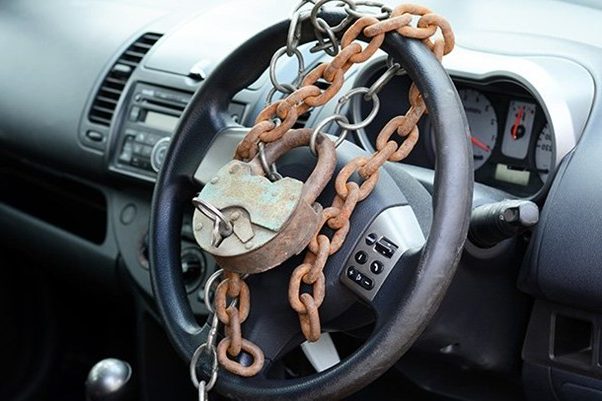WE HAD A GREAT QUESTION from long-term seniordriveraus supporter (and advocate for the over-50s) John Deeks. He asks, “If a new car looked really juicy to car thieves, what steps would you take over and above what the car supplies as anti-theft protocols?”
He adds, “Obviously, you’re never going to stop somebody who seriously wants to take your car, but what would you do to reduce the chances?”
Car theft has long been a problem, and it seems whatever somebody may come up with to deter a car theft, car thieves can find a way around it. And car theft is increasing; in Victoria, for example, 2024 saw its highest level of car theft in two decades with 25,143 car thefts and 3769 attempted car thefts reported (and probably many more unreported).
Of course, in the old (pre-technology obsessed) days, keeping your car safe was as simple as removing the rotor from the distributor (easily done, and easily reinstated), but these days, almost all modern cars use transistorised ignition, so no distributor, and no rotor!

Conversely, we always get a laugh from the window sticker that shows a manual gear change pattern alongside the words “Millennial anti-theft device fitted” – most younger drivers are completely bamboozled by a manual gearchange! And then there were the thieves in the UK who targeted an older car and failed to steal it because they couldn’t get it started… they’d never before encountered a manual choke!
However, modern cars, despite being more resistant to theft, can still be stolen.

Modern thieves are using RFID key signal cloning devices to copy the signal emitted by your keyless entry car key fob, giving them access to your car and, in some cases, the ability to just get in and drive away. You can circumvent this by spending around $5 on a Faraday pouch to store your keys, making it impossible for them to latch onto the signal from your keys.
But most car thefts are opportunistic, or low tech.
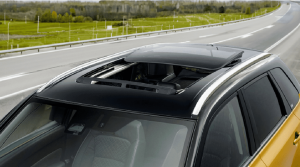
The best protection is usually the simplest
- The first line of defence is the most basic: ALWAYS LOCK YOUR CAR. Thieves will always seek out the easiest target, and none is more vulnerable than an unlocked car.
- Close the windows and the sunroof. Open windows and open sunroofs give car thieves easy access to your car. Even when parking briefly (and especially in service stations), close them all and lock the car.
- Where possible, park in well-lit areas. Thieves love the cover of darkness and will see more opportunity if your car is parked in the shadows.
- Where possible, park in secure parking facilities, locked garages or driveways, especially overnight.
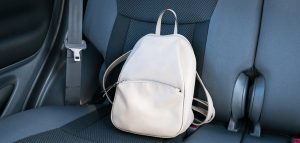
- Never leave valuables in plain sight in your car. The temptation to smash a window and steal a phone, laptop, wallet or other valuable item may be irresistible, so keep them out of sight. And the expense and inconvenience of replacing a smashed window may be more than the value of the pilfered item.

- Remove registration papers or any other documentation that may reveal your home address. It’s bad enough having your car stolen, but it’s considerably worse if it leads to your home being burgled as well.
- Mark your property with your driver’s licence number (prefixed with the appropriate state code). Easily identifiable items are more difficult (if not impossible) to sell.

Low tech often works
As we said before, car thieves are opportunists (and lazy!). If a car thief sees a visible deterrent, he or she may move onto another, easier-to-steal vehicle. It’s sad but true, your first priority is ensuring it’s not your car that gets stolen.
Highly visible, quite effective and inexpensive is the good old steering wheel lock.
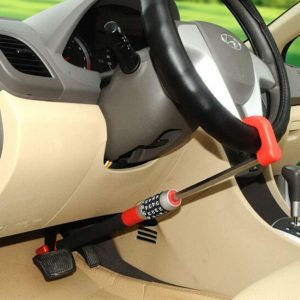
Car steering locks work by preventing the steering wheel from being turned. The ignition can still be turned on, but the car will be impossible to steer unless the steering lock is removed.
Some steering locks come with alarms and most are locked or unlocked using a key. One important point: keep the key somewhere safe and memorable; a steering lock won’t do its job if you leave the key in the glove box or console and a thief finds it. And make sure you remember where you’ve kept it, otherwise you’ll need a locksmith to release it if you can’t find the key.
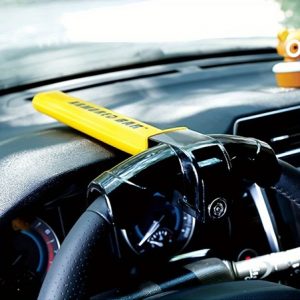
Choose one in a bright colour so it’s immediately visible to the thief (it’s not failsafe; we once had a side window smashed and broken into even though the car was left deliberately unlocked and with the glove box open to show there was nothing inside worth stealing. Car thieves are not only opportunistic and lazy, but often very stupid.)
There are various types of steering lock available (some even immobilise the brake pedal for an extra layer of security, but these can be tricky to use for people with mobility issues). Talk to an auto retailer about which type is best suited to you and your car. Cord type steering locks are easily stored, but can be easily cut by thieves. Full cover locks that completely enclose the steering wheel tend to be heavy and cumbersome to store.
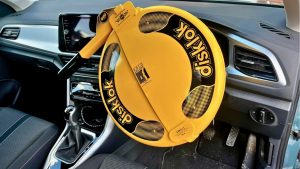
And talking about storage, locks tend to be heavy and unforgiving, so ensure that your steering lock is securely stowed in your car when not in use so that it doesn’t move around or cause damage to the interior. Or an occupant.
Higher-tech protection
If you want a higher level of protection than you get from a simple steering lock, there are plenty of options, at various price points.

- A high degree of protection is offered by car alarms and immobilisers. An alarm system needs to be visible (or have warning labels affixed so a thief knows there’s one fitted). Combine an alarm with an engine immobiliser (make sure it meets Australian Standard 4601:1999) and you can fairly confident next morning your car will still be where you parked it. But the proliferation of alarms (and the number of false alerts) can mean that even if your car alarm is going off, people may tend to ignore it.
![]()
- GPS trackers are an excellent way of helping laws enforcement locate your vehicle if it is stolen. A tracker can follow the route taken by the thief, tell you where it’s been dumped, and some systems even give you the ability to remotely disable the engine, bringing your car (and the thief) to a standstill.
- An OBD port is a standardised 16-pin plug in vehicles that allows access to the computer for analysis and monitoring. However, it can also allow thieves to access your vehicle to reprogram keys or bypass security systems. It is usually located in the passenger compartment under the dashboard. You can buy a lock that makes access to the OBD port more difficult.
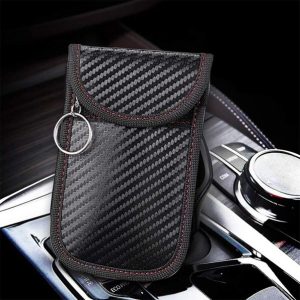
- As mentioned earlier, protect your key fobs from relay attacks by storing them in a Faraday pouch. A cheaper (and far less attractive) option is to wrap them in aluminium foil.
- Another popular option is to have an auto electrician install a hidden kill switch. One example is a switch that isolates the battery (but this often causes the car alarm to activate when reconnected). An alternative is a kill switch disrupts the car’s starting system by deactivating the fuel pump, ignition or starter). Talk to your auto electrician about which is best for you, and most convenient.
It’s a sad but inevitable fact of life that some other people will always want to take what’s yours.
Using one or more of these deterrents (experts recommend “multi-layered” security) is the best way not to find an empty space where you parked your car. But as John Deeks accurately points out, if a thief is determined to steal your car, almost nothing will deter him/her.
